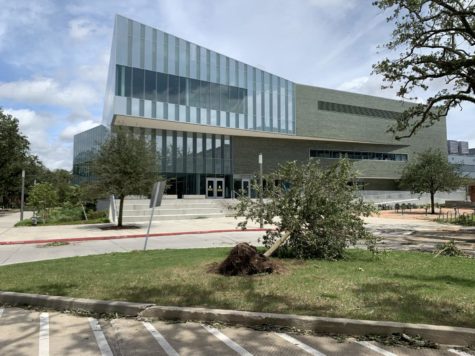Inside Tulane’s Ida evacuation

The morning after Hurricane Ida downed trees, collapsed power lines and flooded roadways throughout southeastern Louisiana, Brian Johnson, associate vice president for campus operations, had an urgent call to make to his contact at the Hyatt hotel chain. He needed hotel rooms for approximately 2,000 students.
Johnson led the largest hurricane evacuation at Tulane University in over a decade. This call — among dozens in the flurry of evacuation preparations — booked five downtown Houston hotels where Tulane students could stay. Tulane also secured 37 coach buses with police escorts to get students out of New Orleans. The team had no other choice, as it would take weeks to restore New Orleans’ power grid. Top administrators worked from Building 85 on campus to sort out the details of the evacuation.
In five hours, Johnson had the hotels booked in Houston, and his team laid out rough sketches of a plan. Staff members used two-way radios to maintain communication in the wake of unstable cell service, which he describes as “sort of smoke signals.”
Donald Veals, emergency preparedness and response manager, sourced buses through three companies and a partnership with Tulane University Athletics.
Veals said that each hurricane season, the university contracts an out-of-state bus service for standby.
On Monday, Aug. 30, Tulane sent an email that all remaining students would be evacuated to Houston starting at 10 a.m. on Aug. 31.
Patrick Norton, senior vice president and chief operating officer, said Tulane chose to evacuate because Orleans Parish lacked the power to provide necessities like food and fuel.
“It was just not a safe environment,” Norton said.
Norton has been on campus for the duration of the storm, even going so far as sleeping in Building 85. During the evacuation on Tuesday, he was on Brown Field with President Mike Fitts and Robin Forman, senior vice president for academic affairs and provost, among others.
“It was like all hands on deck to make sure our students were able to get on the buses,” Norton said.
Norton added that Tulane has multiple campuses downtown and a primate research center in Covington, Louisiana. According to him, researchers there were scrambling to keep specimens and animals protected as they lost air conditioning and the temperature started to rise.
“This herculean effort was possible through the amazing dedication of our staff, many of whom had endured hurricane damages to their own home and property, and yet worked around the clock to relocate our students to Houston,” Fitts said.
In Houston, Tulane gave students three days to arrange travel plans after arriving. About 600 students unable to travel home will stay in Houston during the University’s shutdown, Johnson said.
Last week’s evacuation was not a first for Tulane. Students evacuated for Hurricane Katrina four days into the 2005 school year. After the levees broke, submerging New Orleans, former university President Scott Cowen had to use a boat, golf cart, dump truck and helicopter to leave the city. Tulane did not bring students back until January. They created temporary apartments and hosted students in hotels. When that was not enough, the university docked a cruise ship in the Mississippi River which students and faculty lived out of for several months.
“There’s one thing I know for sure,” Johnson said. “We will learn from this and evolve because we have to.”
Your donation will support the student journalists of Tulane University. Your contribution will allow us to purchase equipment and cover our annual website hosting costs.


